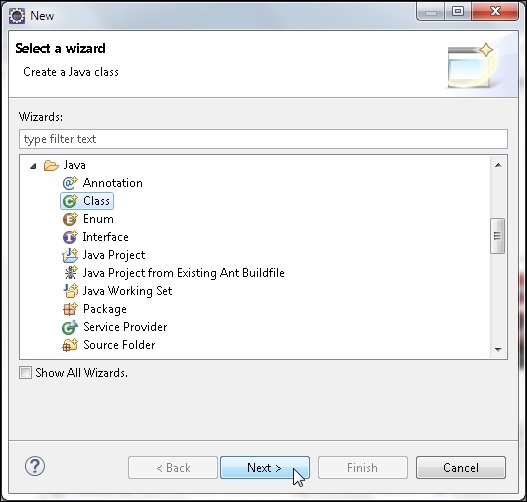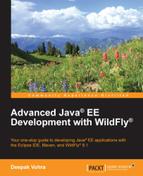In EJB 3.x, an entity is a POJO (Plain Old Java Object) persistent domain object that represents a database table row. As an entity is a Java class, create a Java class in the jboss-ejb3-ejb subproject of the jboss-ejb3 project. Select File | New. In the New window, select Java | Class and click on Next:

Select/specify jboss-ejb3/jboss-ejb3-ejb/src/main/java as the Java Source folder, org.jboss.ejb3.model as the Package, and Catalog as the class Name. Click on Finish:

Similarly, add Java classes for the Edition.java, Section.java, and Article.java entities, as shown in the following Project Explorer:

Next, we develop the EJB 3.x entities. A JPA persistence provider is required for the EJB entities, and we will use the Hibernate persistence provider. The Hibernate persistence provider has some peculiarities that need to be mentioned, as follows:
- If an entity has more than one non-lazy association of the following types, Hibernate fails to fetch the entity:
- The
java.util.List, java.util.Collectionproperties annotated with@org.hibernate.annotations.CollectionOfElements - The
@OneToManyor@ManyToManyassociations not annotated with@org.hibernate.annotations.IndexColumn - Associations marked as mappedBy must not define database mappings (such as @JoinTable or @JoinColumn)
- The
We will develop the Catalog, Edition, Section, and Article class with one-to-many relationship between the Catalog and Edition class, the Edition and Section class, and the Section and Article class, as shown in the following UML class diagram:

Annotate the Catalog entity class with the @Entity annotation and the @Table annotation. If the @Table annotation is not used, then the entity name is used as the table name by default. In the @Table annotation, specify the table name as CATALOG and uniqueConstraints, using the @UniqueConstraint annotation for the id column. Specify the named queries as findCatalogAll, which selects all Catalog and findCatalogByJournal entities. This selects a Catalog entity by Journal, using the @NamedQueries and @NamedQuery annotations:
@Entity
@Table(name = "CATALOG", uniqueConstraints = @UniqueConstraint(columnNames = "ID"))
@NamedQueries({
@NamedQuery(name="findCatalogAll", query="SELECT c FROM Catalog c"),
@NamedQuery(name="findCatalogByJournal",
query="SELECT c FROM Catalog c WHERE c.journal = :journal")
})
public class Catalog implements Serializable {
}Specify the no-argument constructor, which is required in an entity class. The Catalog entity class implements the Serializable interface to serialize a cache-enabled entity to a cache when persisted to a database. To associate a version number with a serializable class for a serialization runtime, specify a serialVersionUID variable. Declare String variables for id and journal bean properties and for a collection of Set<Edition> type, as the Catalog entity has a bi-directional one-to-many association to Edition. The collection is chosen as Set for the reason mentioned earlier. Hibernate does not support more than one EAGER association of the java.util.List type. Add get/set methods for the bean properties. The @Id annotation specifies the identifier property. The @Column annotation specifies the column name associated with the property. The nullable element is set to false as the primary key cannot be null.
Note
If we were using the Oracle database, we would have specified the primary key generator to be of the sequence type, using the @SequenceGenerator annotation. The generation strategy is specified with the @GeneratedValue annotation. For the Oracle database, the generation strategy would be strategy=GenerationType.SEQUENCE, but as MySQL database supports auto increment of primary key column values by generating a sequence, we have set the generation strategy to GenerationType.AUTO.
Specify the bi-directional one-to-many association to Edition using the @OneToMany annotation. The mappedBy element is specified on the non-owning side of the relationship, which is the Catalog entity. The cascade element is set to ALL. Cascading is used to cascade database table operations to associated tables. The fetch element is set to EAGER. With EAGER fetching the associated entity, collection is immediately fetched when an entity is retrieved:
// bi-directional many-to-one association to Edition
@OneToMany(mappedBy = "catalog", targetEntity=org.jboss.ejb3.model.Edition.class, cascade = { CascadeType.ALL }, fetch = FetchType.EAGER)
public Set<Edition> getEditions() {
return this.editions;
}
}As mentioned earlier, associations marked with mappedBy must not specify @JoinTable or @JoinColumn. The get and set methods for the Edition collection are also specified. The Catalog.java entity class is available in the code download for the chapter at http://www.packtpub.com/support.
Next, develop the entity class for the EDITION database table: Edition.java. Specify the @Entity, @Table, @Id , @Column, and @GeneratedValue annotations, as discussed for the Catalog entity. Specify the findEditionAll and findEditionByEdition named queries to find Edition collections. Specify the bean properties and associated get/set methods for id and edition. Also, specify the one-to-many association to the Section entity using a collection of the Set type. The bi-directional many-to-one association to the Catalog relationship is specified using the @ManyToOne annotation, and with cascade of type PERSIST, MERGE, and REFRESH. The Edition entity is the owning side of the relationship. Using the @JoinTable annotation, a join table is included on the owning side to initiate cascade operations. The join columns are specified using the @JoinColumn annotation. The Edition.java entity class is available in the code download for the chapter.
Develop the entity class for the SECTION table: Section.java. Specify the findSectionAll and findSectionBySectionName named queries to find Section entities. Specify the id and sectionname bean properties. Specify the bi-directional many-to-one association to Edition using the @ManyToOne annotation and the bi-directional one-to-many association to Article using @OneToMany. The @JoinTable and @JoinColumn are specified only for the @ManyToOne association for which Section is the owning side. The Section.java entity class is available in the code download for the chapter.
Specify the entity class for the ARTICLE table: Article.java. The Article entity is mapped to the ARTICLE database table using the @TABLE annotation. Add the findArticleAll and findArticleByTitle named queries to find Article entities. Specify id and sectionname bean properties and the associated get/set methods. The Article entity is the owning side of the bi-directional many-to-one association to Section. Therefore, the @JoinTable and @JoinColumn are specified. The Article.java class is available in the code downloaded for the chapter.
